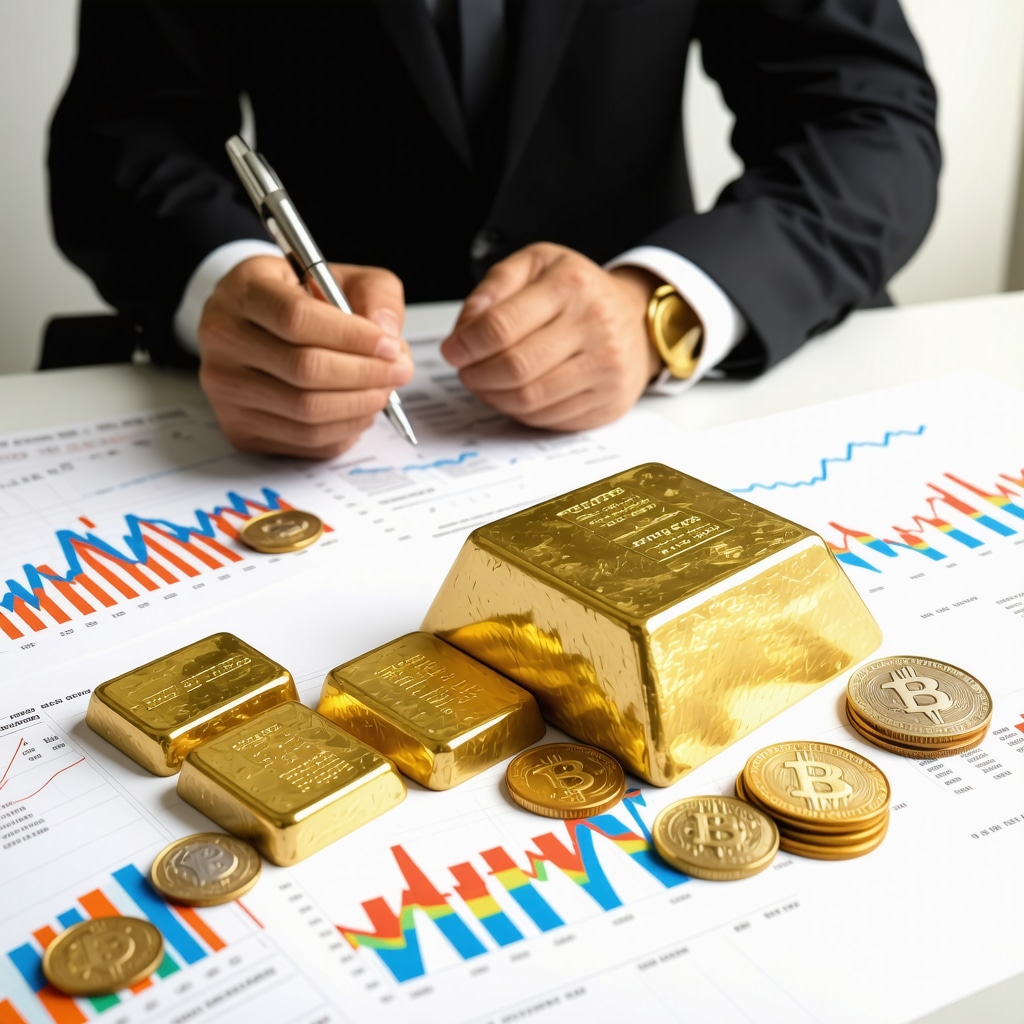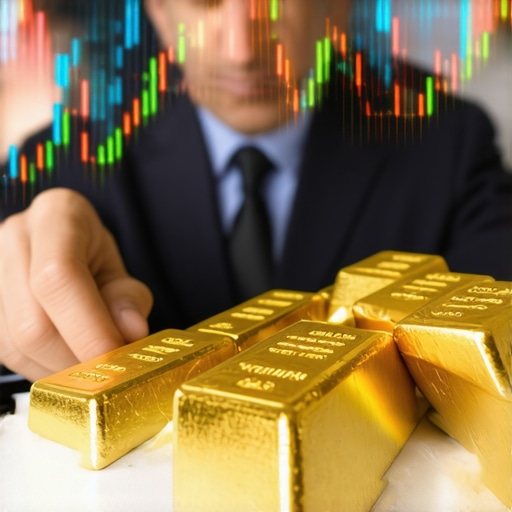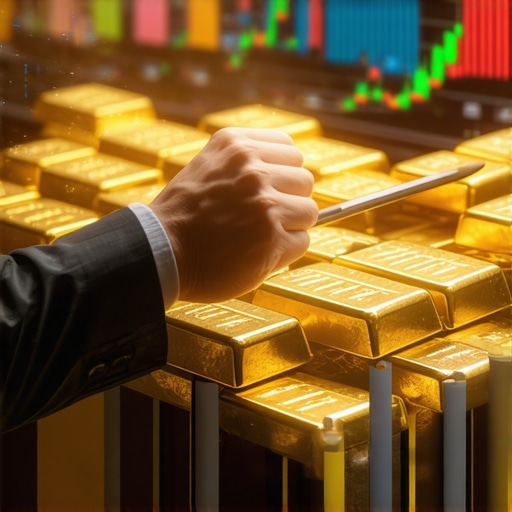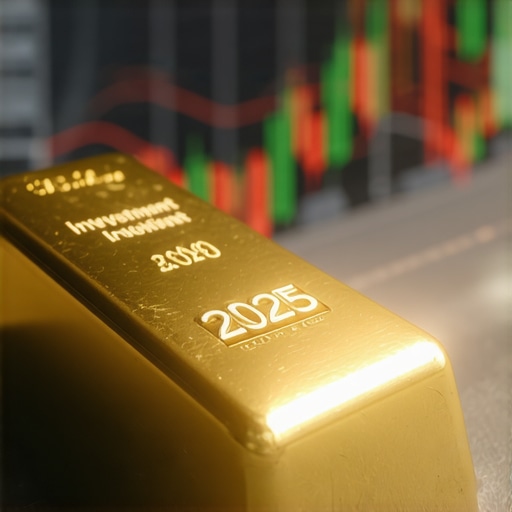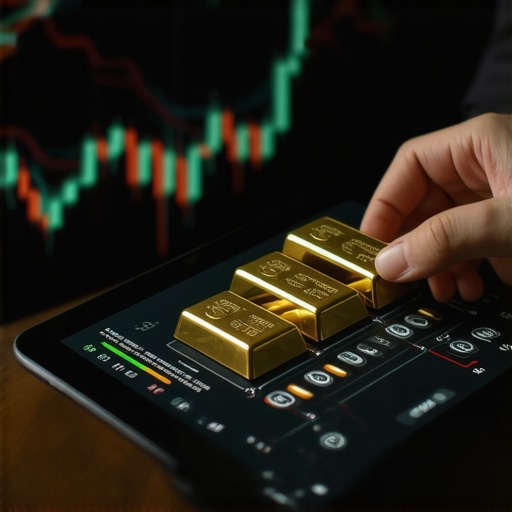Strategic Foundations for Maximizing Long-Term Gold Investment Returns
Gold remains a cornerstone asset for portfolio diversification, particularly in volatile economic environments characterized by inflationary pressures and geopolitical uncertainties. Expert investors understand that leveraging gold’s intrinsic properties requires nuanced strategies that go beyond simple accumulation. A sophisticated approach integrates market dynamics, asset type differentiation, and timing to optimize long-term gains while mitigating risk.
Dissecting Gold Investment Vehicles: Balancing Physical and Financial Instruments
Investors must distinguish between physical gold—such as bullion, coins, and bars—and financial instruments like gold ETFs, mutual funds, and mining stocks. Each vehicle entails unique liquidity profiles, cost structures, and exposure to market volatility. For instance, physical gold offers direct ownership and inflation hedge but may involve storage and authenticity verification challenges. Conversely, gold ETFs provide ease of trade and diversification but subject investors to counterparty risk and management fees. A balanced portfolio often synergizes these elements to harness gold’s multifaceted benefits.
How Do Central Bank Gold Purchases Influence Long-Term Market Trends?
Central banks’ gold acquisition policies significantly sway global gold supply-demand dynamics, which in turn affect price trajectories and investor sentiment. Analyzing data from sources such as the World Gold Council reveals that sustained central bank buying tends to underpin gold prices by tightening supply and signaling institutional confidence. However, timing and geopolitical context complicate these effects, requiring investors to integrate macroeconomic indicators with central bank activity for informed decision-making. Comprehensive analyses like those found in World Gold Council reports provide authoritative insight into these mechanisms.
Advanced Portfolio Construction: Leveraging Gold Price Forecasts and Demand Trends
Incorporating predictive analytics on gold price movements and demand trends enhances long-term investment outcomes. Sophisticated investors monitor economic indicators such as inflation rates, currency fluctuations, and geopolitical risk indices to anticipate price inflection points. Additionally, understanding sector-specific demand—jewelry, technology, and investment—enables tactical asset allocation adjustments. For detailed analysis, resources like gold price forecast 2025 provide critical data to inform timing and volume of investments.
Integrating Hedging Techniques: Using Gold as a Defensive Asset in Volatile Markets
Sophisticated gold investment strategies often incorporate hedging to offset systemic risks within broader portfolios. Gold’s inverse correlation to equities and currencies under crisis conditions makes it an effective tool to preserve capital. Techniques include dynamic rebalancing between physical gold and derivatives, tactical entry into gold mining equities, and utilizing gold-backed ETFs with low expense ratios. Mastery of these approaches demands continuous market surveillance and adaptability to shifting economic landscapes.
Call to Action: Elevate Your Gold Investment Strategy with Expert-Level Resources
To deepen your expertise and refine your gold investment tactics, explore advanced insights on smart gold investment strategies for retirement security. Engage with professional communities and contribute your analytical perspectives to enrich collective knowledge and stay at the forefront of gold market evolution.
Dynamic Gold Allocation: Adjusting Strategies for Market Cycles
Successful gold investment transcends static allocation by embracing dynamic strategies that reflect evolving market cycles. Investors attuned to macroeconomic shifts can optimize gold exposure by timing purchases and sales according to phases of inflation, interest rate changes, and geopolitical tensions. During periods of rising inflation or economic uncertainty, increasing physical gold holdings or gold ETFs can provide a robust hedge. Conversely, in stable or deflationary environments, reducing exposure or pivoting toward gold mining stocks may enhance returns through operational leverage.
This adaptive approach requires continuous monitoring of economic indicators and market sentiment, making tools such as economic calendars and volatility indices indispensable. For an in-depth exploration of these market influences, consider reviewing expert gold price forecasts and market insights that analyze key drivers shaping 2025 trends.
What Role Does Technological Innovation Play in Shaping Gold Demand and Investment Opportunities?
Technological advancements are increasingly influencing gold demand beyond traditional sectors like jewelry and investment. Innovations in electronics, medical devices, and even emerging fields such as nanotechnology and green energy solutions are expanding gold’s industrial applications. This evolution introduces nuanced demand trends that savvy investors must consider when evaluating gold’s long-term value proposition.
For example, gold’s exceptional conductivity and corrosion resistance make it indispensable in high-performance electronics and catalysts used in hydrogen fuel cells. As global emphasis on sustainable energy and advanced technologies intensifies, gold’s industrial demand could experience sustained growth, potentially offsetting cyclical investment-driven price fluctuations.
Incorporating these technological demand drivers into portfolio analysis enhances strategic foresight, enabling investors to anticipate shifts in gold consumption patterns. Further, companies at the forefront of gold-based technological innovation might represent compelling equity investment opportunities within the mining sector.
Risk Management: Navigating Volatility with Diversification and Tactical Hedging
While gold is often perceived as a safe haven, its price can exhibit significant volatility influenced by currency movements, interest rates, and speculative trading. Effective risk management entails diversifying across various gold investment forms and integrating tactical hedging techniques tailored to individual risk tolerance and investment horizons.
For instance, combining physical gold holdings with gold ETFs and selective mining stocks can balance liquidity needs against exposure to operational risks. Utilizing options and futures markets for hedging allows investors to protect gains or limit downside during turbulent periods. Such sophisticated strategies demand rigorous analysis and timely execution to align with portfolio objectives.
Assessing Environmental, Social, and Governance (ESG) Factors in Gold Mining Investments
Increasingly, ESG considerations are pivotal in evaluating gold mining stocks, as sustainable practices directly affect operational legitimacy and long-term profitability. Investors should scrutinize mining companies’ adherence to environmental regulations, social impact, and governance standards to mitigate reputational and regulatory risks.
Companies embracing responsible mining practices and transparent governance often demonstrate resilience amid regulatory changes and shifting market expectations, enhancing investment appeal. Resources like the MSCI ESG Investing framework provide critical evaluation criteria for integrating ESG factors into gold mining investment decisions.
Balancing financial returns with ethical considerations aligns investment strategies with broader societal values, fostering sustainable wealth creation.
Leveraging Data Analytics: Enhancing Decision-Making with Market Intelligence
Advanced investors harness big data and artificial intelligence to decode complex gold market patterns and forecast price movements with greater precision. Machine learning models analyze vast datasets—from mining production statistics to macroeconomic indicators and sentiment analysis—to identify subtle correlations and emerging trends.
Deploying such analytical tools facilitates proactive portfolio adjustments and timely entry or exit points, elevating investment performance. Integrating these insights with traditional fundamental and technical analysis creates a multidimensional understanding essential for navigating contemporary gold markets.
For investors keen on data-driven strategies, exploring platforms offering proprietary analytics can provide a competitive edge in the gold investment landscape.
Elevate Your Gold Investment Expertise
Engage with cutting-edge research and market analysis to refine your gold investment approach. Share your perspectives or questions in the comments below and explore further resources on advanced gold trading techniques to stay ahead in 2025.
Decoding Market Timing: Integrating Macro-Financial Signals for Gold Investment Optimization
Mastering the timing of gold investments entails decoding a complex web of macro-financial signals and geopolitical catalysts. Advanced investors track leading indicators such as real interest rates, U.S. dollar strength, and sovereign debt metrics to anticipate shifts in gold’s risk-reward profile. For example, declining real interest rates often diminish the opportunity cost of holding non-yielding gold, thereby boosting its appeal. Similarly, periods of dollar weakness can drive gold prices higher due to inverse correlation dynamics.
Yet, the challenge lies in synthesizing these signals within a probabilistic framework that accounts for market noise and black swan events. Employing econometric models alongside sentiment indices enhances the precision of entry and exit strategies. Integrating these approaches with technical analysis—such as Fibonacci retracements and moving average convergence divergence (MACD)—enables layered decision-making that mitigates timing risks.
How Can Sophisticated Investors Navigate Gold Price Volatility During Geopolitical Crises?
Geopolitical crises inject sudden volatility into gold markets, often causing sharp price spikes followed by retracements. Savvy investors employ a combination of position sizing, stop-loss orders, and options strategies to manage exposure during such turbulent periods. Utilizing gold options—like protective puts or call spreads—can hedge downside risk while preserving upside potential.
Moreover, monitoring real-time geopolitical intelligence feeds and macroeconomic data releases allows for anticipatory repositioning. This proactive stance helps in capturing transient price dislocations without succumbing to panic-driven decisions. Resources such as the Investopedia Geopolitical Risk Overview provide foundational frameworks, but integrating bespoke data analytics is critical for nuanced execution.
Technological Disruption and Gold: Emerging Demand Vectors Transforming Investment Paradigms
As technological frontiers advance, gold’s role as an industrial metal is evolving in unprecedented ways. Beyond its traditional uses, gold is pivotal in cutting-edge sectors such as quantum computing, advanced medical diagnostics, and sustainable energy technologies. Its unparalleled electrical conductivity and biocompatibility position it uniquely for innovations like implantable biosensors and photonic devices.
These emergent applications engender new demand trajectories that can decouple gold prices from classical macroeconomic drivers, introducing idiosyncratic growth factors. Investors attuned to these shifts can identify mining companies with robust R&D pipelines or strategic partnerships in high-tech domains, thereby leveraging equity exposure beyond bullion holdings.
Furthermore, the integration of gold nanoparticles in environmental remediation and catalysis aligns with global sustainability imperatives, potentially amplifying industrial demand over the medium to long term.
Evaluating ESG Integration: A Paradigm Shift for Sustainable Gold Mining Investments
The rise of Environmental, Social, and Governance (ESG) criteria is reshaping investment frameworks, especially within the gold mining sector. Mining operations historically associated with environmental degradation and social controversies now face heightened scrutiny from institutional investors and regulators.
Advanced ESG analysis goes beyond compliance checklists to incorporate quantitative metrics such as carbon footprint intensity, water usage efficiency, community stakeholder engagement scores, and governance transparency indices. Utilizing ESG ratings from specialized agencies—like MSCI’s ESG Ratings or Sustainalytics—enables investors to benchmark mining companies rigorously.
Investors who prioritize ESG-aligned gold mining stocks may benefit from reduced regulatory risks, enhanced brand reputation, and access to green financing mechanisms, which collectively contribute to sustainable value creation. This strategic alignment with ethical investing trends also caters to growing demand from socially conscious capital.
Strategic Implications of Digital Gold and Blockchain-Enabled Ownership Models
Emerging digital gold platforms utilizing blockchain technology are revolutionizing ownership, liquidity, and traceability paradigms. Tokenized gold ecosystems enable fractional ownership with real-time verification, lower transaction costs, and enhanced market accessibility.
Such innovations are particularly impactful for institutional investors seeking transparent custody solutions and retail participants aiming for seamless entry and exit. However, navigating regulatory frameworks and counterparty risks remains critical, underscoring the importance of due diligence and partnering with reputable platforms.
Integrating digital gold assets into diversified portfolios requires sophisticated understanding of smart contracts, custodial arrangements, and cybersecurity considerations.
Investors interested in exploring blockchain-based gold investment vehicles can benefit from specialized research and participation in expert forums to stay abreast of evolving best practices.
Engage with Advanced Gold Investment Discourses
Elevate your investment acumen by engaging with cutting-edge research and community insights. Explore comprehensive analyses on advanced gold investment strategies for 2025 and participate in expert webinars to deepen your understanding of market dynamics and technological disruptions shaping the gold landscape.
Exploring Blockchain-Enabled Gold Ownership: Revolutionizing Liquidity and Transparency
The advent of blockchain technology is enabling unprecedented transformation in gold investment paradigms. Tokenization of physical gold assets through smart contracts offers fractional ownership, enhancing liquidity and democratizing market access for both institutional and retail investors. This shift reduces transaction friction and introduces real-time traceability, addressing longstanding concerns regarding provenance and custody.
However, integrating blockchain-based gold tokens demands rigorous due diligence to navigate regulatory frameworks and counterparty risks. Investors must evaluate platform credibility, custodial security measures, and compliance with anti-money laundering (AML) and know-your-customer (KYC) standards to safeguard assets effectively.
What Are the Key Considerations When Incorporating Digital Gold Tokens into a Diversified Portfolio?
Incorporating digital gold tokens requires balancing innovative technological advantages with traditional investment criteria. Key considerations include assessing token liquidity, underlying asset verification, platform transparency, and cybersecurity resilience. Moreover, understanding smart contract governance and potential smart contract vulnerabilities is essential to mitigate operational risks.
From a portfolio perspective, digital gold tokens can complement physical gold and gold equities by providing flexible exposure and rapid rebalancing capabilities. Strategic allocation should factor in volatility profiles and correlation with conventional gold instruments to optimize risk-adjusted returns.
For in-depth guidance, Investopedia’s tokenization overview offers comprehensive insights into digital asset frameworks and investment implications.
Elevating ESG Integration: Benchmarking Gold Mining with Advanced Sustainability Metrics
Progressive investors are advancing beyond rudimentary ESG screening to adopt quantitative sustainability analytics in gold mining evaluations. Utilizing granular metrics such as greenhouse gas emission intensities, water stewardship indices, and community impact assessment scores allows for discriminating identification of miners excelling in environmental and social responsibility.
Furthermore, governance assessments now incorporate board diversity, executive remuneration alignment, and anti-corruption policies, which are pivotal in sustaining long-term operational viability and investor confidence.
Advanced ESG integration aligns with emerging regulatory landscapes and the rising demand for responsible investment products, thereby reducing systemic risks and unlocking access to green financing avenues.
Harnessing AI-Driven Predictive Analytics for Gold Price Volatility Management
Machine learning and artificial intelligence are increasingly instrumental in decoding multifactorial gold price drivers. By ingesting diverse datasets—including geopolitical events, macroeconomic indicators, and social media sentiment—AI models can generate probabilistic forecasts that enhance timing and sizing of gold trades.
These advanced analytical frameworks enable dynamic hedging strategies and portfolio optimization tailored to evolving market conditions. Combining AI insights with traditional fundamental and technical analysis deepens strategic acumen, empowering investors to anticipate and capitalize on volatility spikes effectively.
Call to Action: Empower Your Gold Investment Decisions with Next-Generation Tools and Insights
Embrace the future of gold investing by integrating blockchain innovations, rigorous ESG criteria, and AI-powered analytics into your portfolio management. Explore specialized resources and join expert forums at Advanced Gold Investment Strategies for 2025 to refine your approach and engage with thought leaders shaping this dynamic landscape.
Expert Insights & Advanced Considerations
Dynamic Allocation: Synchronizing Gold Exposure with Macroeconomic Cycles
Refined gold investment demands an agile approach that adjusts allocations in response to inflation trends, interest rate shifts, and geopolitical developments. Investors who tactically augment physical gold during inflationary phases while pivoting to mining equities in stable cycles can optimize portfolio resilience and returns. This dynamic calibration surpasses static strategies, requiring vigilant monitoring of economic indicators and market sentiment. Explore how to effectively apply these principles in gold price forecasts and market insights.
Integrating ESG and Technological Innovations in Gold Mining Investments
Incorporating Environmental, Social, and Governance (ESG) metrics alongside an understanding of emerging industrial demand from technological advancements transforms gold mining stock evaluation. Companies pioneering sustainable practices while leveraging gold in cutting-edge sectors like green energy and electronics present differentiated investment opportunities. Prioritizing miners with strong ESG scores and robust R&D pipelines can mitigate risks and capture growth from evolving demand vectors, as detailed in best gold mining stocks for long-term gains.
Harnessing AI and Big Data Analytics for Predictive Gold Market Intelligence
Advanced investors increasingly utilize AI-driven models to interpret multifactorial data sets ranging from geopolitical indicators to social media sentiment. These predictive analytics enable superior timing of entries and exits, dynamic hedging, and enhanced portfolio optimization. Blending such quantitative tools with fundamental and technical analysis creates a multidimensional strategy that addresses gold market volatility proactively. For practical applications, see advanced gold trading techniques.
Digital Gold and Blockchain: Navigating New Frontiers in Ownership and Liquidity
Tokenized gold ownership via blockchain platforms revolutionizes access, traceability, and liquidity, especially for fractional investors. While offering compelling advantages, these innovations necessitate rigorous due diligence regarding platform security, regulatory compliance, and smart contract governance. Incorporating digital gold tokens alongside traditional holdings demands nuanced portfolio integration strategies to balance innovation with risk management. Consider insights from blockchain-enabled gold ownership for deeper understanding.
Curated Expert Resources
- World Gold Council Reports: Authoritative analyses on central bank gold purchases and global supply-demand dynamics, critical to understanding institutional influences on gold price trends. (World Gold Council)
- MSCI ESG Investing Framework: Comprehensive ESG rating methodologies that assist in evaluating sustainability and governance factors within gold mining investments. (MSCI ESG Investing)
- Investopedia Tokenization Overview: Detailed explanations on digital asset frameworks, essential for understanding blockchain-based gold investment vehicles. (Investopedia)
- BuyingGoldNow Advanced Strategy Guides: In-depth resources on gold price forecasting, hedging, and trading techniques tailored for 2025 market conditions. (Advanced Gold Investment Strategies for 2025)
- Specialized Analytics Platforms: Proprietary AI and big data tools that decode complex gold market patterns, offering predictive insights for sophisticated investors.
Final Expert Perspective
The evolving landscape of gold investment demands mastery beyond mere acquisition, encompassing dynamic allocation strategies, rigorous ESG integration, and the adoption of cutting-edge technologies including AI analytics and blockchain innovations. These advanced dimensions collectively empower investors to navigate volatility, harness emerging demand drivers, and optimize portfolio performance in 2025 and beyond. Embracing these insights elevates your gold investment approach from conventional tactics to expert-level craftsmanship.
To deepen your understanding and participate in ongoing discourse, we invite you to explore more on advanced gold investment strategies and share your professional insights. Engagement with this dynamic community fosters continuous learning and positions you at the forefront of gold market innovation.






